Please click here for a rendering of Srisukta (The link seems to work better on Google Chrome)
Let’s briefly, talk about each of the fifteen mantras of the Srisukta.
Mantra One
ॐ हिरण्यवर्णां हरिणीं सुवर्णरजतस्रजाम् |
चन्द्रां हिरण्मयीं लक्ष्मीं जातवेदो म आवह ||१||
Hiraņya varnám hariņīm suvarna-rajata-srajám
Chandrám hiranmayīm lakshmīm jatavedo ma avaha|(1)
[The Rishi of the mantra is Jatavedasa (Agni); its Chhandas is Anustubh; its Devata is Mahalakshmi the goddess who grants prosperity of all kinds. Srim is the Bija of the mantra; Hrim is its Shakthi; and, Klim is its Kilaka. Its viniyoga is threefold: adibhautika, adidaivika and aadhyaatmika. The three refer to Agni, as fire on earth; to Sun-moon, as the deities that bestow fulfilment in life purushartha; and, to the resolute determination (sankalpa) in man.]
Oh..! The all-knowing Jatavedasa, invoke in me Lakshmi the symbol of wealth , of enchanting form, of golden lustre, splendorous like gold, adorned with brilliant ornaments of gold and silver ; and, beautiful like the female deer that shines like moon.
***
1.1. The opening mantra of Srisukta is a prayer submitted, primarily, to Agni addressed as the all-knowing Jatavedasa, who is the source of all knowledge (Veda); and, is the very personification of Yajna-purusha Vishnu (yajño vai viṣṇuḥ). Agni is requested to bestow all those signs (Lakshana, Lakshmi) of happiness, wealth and prosperity that a person desires.
1.2. Lakshmi represents the sense of beauty, grace, wealth and happiness that is manifest in all existence. Lakshmi is the very embodiment of all the auspicious virtues that inspire life. Lakshmi is also understood as the one who ignites the desire for knowledge that inspires us to attain the highest state in human life.
1.3. Lakshmi’s association with gold that shines, signifies purity (pavitram vai hiranyam) and brilliance. The deer stands for enchanting allure; the fleeting desire that draws one out in its pursuit. Just as it is not easy to chase and catch an eluding deer that runs away fast, it is also hard to attain and hold on to success, wealth and fame that are ever transitory. Sri is thus Harini the deer that sparkles. And Harini is also the sheen of turmeric (haridra-bha); the sign of auspiciousness and a remedy against infections.
2.1. In Tantra, Sri , revered as Devi, is Matruka , the Mother (matrka-mayi), the Supreme Mother Goddess (devim mataram sriyam), She is also the power of sound (Matrika Shakti) , the matrix of the cosmos manifest as the alphabets. The phrase ‘suvarna-rajata-srajaam’ is also understood to mean that Sri is adorned with Matrika Mala, the garland of letters/alphabets woven with vowels (suvarna) and consonants (rajata). Sri is thus mantra-mayi the origin and essence of all mantras.
3.1. Chandraam, the aspect of moon, denotes mellow glow that spreads happiness (aahlada). Sri is Chandra, bright (Chandrah chandate) and beautiful as the moon that delights the hearts of all (sakala jana-ahlada–karini). Further, in the Srividya tradition, the worship of the Devi follows the phases of the moon in a fortnight. Her Vidya is therefore termed as Chandra-vidya or Chandra-kala-vidya. And, the Devi is worshipped through her pancha-dashi-mantra, the mantra of fifteen syllables.
4.1. Sri , when personified as goddess, is described as radiant ; shining like gold; decorated with splendid ornaments; wearing a brilliant crown; seated on a magnificent lotus-throne studded with gems; holding freshly blossomed beautiful lotus flowers; and, served by a pair of elephants pouring over her golden pots of nectar.
The Dhyana–sloka of the first mantra describes Gaja-lakshmi.

Kaantyaa kanchana -sannibhaam himagiri-prakhyairsh-chaturbhir-gajaih
hastot-kshipta-hiranmaya-amrita-ghata-raasichyamaanaam – shriyam |
nana-ratna-samujwalaam karala-satpadmam kiriitojwalaam
kshauma-abaddha-nitamba-bimba-lasitaam vande-.aravinda-sthitaam ||
Mantra Two
तां म आवह जातवेदो लक्ष्मीमनपगामिनीम् |
यस्यां हिरण्यं विन्देयं गामश्वं पुरुषानहम् ||२||
Tám ma ávaha játavedo lakśhmīm anapa gáminīm
Yasyám hiraņyam vindeyam gám aśvam puruśhán aham|| (2)
[The Rishi of the mantra is Jatavedasa (Agni); its Chhandas is Anustubh; its Devata is Rajya-lakshmi. The Bija, Shakthi and Kilaka of this mantra are again said to be Hrim, Shrim, and Klim. The viniyoga of the mantra is sakala-sampath-siddhi.]
Oh..! Jatavedasa, please cause Lakshmi to come to me. And, let Lakshmi never ever depart from me. While she is here, I shall gain wealth, riches such as gold, cows, horses and man-power (which term includes friends, family and the other dearer ones).
***
5.1. This is in continuation of the first mantra which ends with the phrase ‘jatavedo ma avaha’, requesting Agni to invoke the presence of Lakshmi. The second mantra qualifies Lakshmi, further, with the epithet: ‘a-anapa-gamini’, the one who does not stray away, but stays with you forever. [The phrase anapa-gamini suggests fleeting nature (chanchala)]
5.2. The gold mentioned in the verse represents immovable wealth (sthavara), while the cattle, horses and men are movable assets (jangama). As Lakshmi enters into one’s life, she brings along with her various kinds of wealth and riches.
6.1. The Dhyana-sloka of the second mantra adores Rajya-lakshmi, riding a horse and leading an army of four divisions (Chaturanga: infantry, cavalry, elephants and chariots). The golden-hued Rajya-Lakshmi grants riches of corn, wealth and happiness.
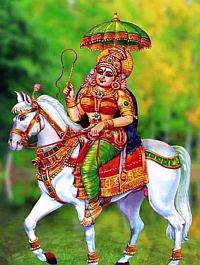
Chaturanga-balopetam dhana-dhanya-sukhesh-wariim |
ashwa-arudha-maha vande raajyalakshmim hiranmayiim ||
Mantra Three
अश्वपूर्वां रथमध्यां हस्तिनादप्रबोधिनीम् |
श्रियं देवीमुपह्वये श्रीर्मादेवीर्जुषताम् ||३||
Aśhwa-pūrvám ratha-madhyám hasti náda prabódhiním
Śhriyam devím upahvaye śhrír ma devír jushatám| (3)
[The Rishi of the mantra is Ananda described as manasa-putra the virtual son of Lakshmi; its Devata is Sri Lakshmi; `U‘ is the Bija, `ta‘ is the Shakti and `Shriim‘ is the Kilaka. The viniyoga is shatru-jayam, rajya-prapti.]
The horses in the lead, the chariots in the middle, followed by the trumpeting elephants, herald the arrival of Sri. I pray to you Jatavedasa, let that magnificent Sri Grace me and come to me.
***
7.1. In the first two mantras, the Sadhaka prays to Agni to cause Sri to come to him. This verse is an answer to his prayers. It heralds the arrival of the glorious Sri in all her grandeur and regal majesty. The procession of her mighty army of infantry, cavalry, elephants and chariots signifies her magnificence and splendour. As it draws closer, the devotee prays that the Grace of the Mother (mam) Sri may descend upon him (jushatam).
7.2. The esoteric meaning of the verse interprets the chariot as the body of the devotee (sareeram ratha-mevathu); at the heart of the Chariot is Sri , the centre of consciousness, as the presiding deity; and , the leaping horses are his senses that need to be controlled (indriyani hayan aahuh).
7.3. The phrase Sriyam-devi is explained as the most radiant (div) Sri Devi who is the refuge of all (shreyaniya) .
8.1. The Dhyana-sloka of the third verse is dedicated to the most auspicious Mother Goddess Soubhagya-lakshmi (saubhaagya-jananiim).
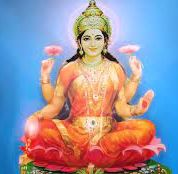
Tadid-warna-purnaam shashil-apanataata -nkayugalaam
darasmeraadhiraam kara-kalita-padmaam dwi-nayanaam |
lasad-griivaam kshaumaa-mshuka-vishada-naabhii sarasijaam
bhajaami tvaam devim pranata-Jana-saubhaagya- jananiim ||
Mantra Four
कां सोस्मितां हिरण्यप्राकारामार्द्रां ज्वलन्तीं तृप्तां तर्पयन्तीम् |
पद्मे स्थितां पद्मवर्णां तामिहोपह्वये श्रियम् ||४||
Kám sósmitám hiranya prákárám árdrám jvalantím triptám tarpayantím
Padme sthitám padma-varnám támihópahvaye śhriyam|| (4)
[The Rishi of the mantra is Ananda; its Chhandas is Bruhati; and its Devata is Sri-Lakshmi. Kam is the Bija; Hrim is the Shakthi; and Shrim is the Kilaka. Its viniyoga is sampath-siddhi and sarasvata-siddhi.]
I welcome the pleasantly smiling, the kind-hearted Sri who is of the nature of Brahman; glowing with a beatific smile , like burnished gold; of beautiful lotus-complexion; and, seated on lotus. She is easily pleased; and, she readily fulfills the desires of her devotees.
The devotee is preparing to welcome Sri.
***
9.1. This mantra, again, refers to Sri’s association with gold (hiranya prákárám) and the lotus (Padme sthitám padma-varnám). Sri is explained as the bright and joyful consciousness that resides in the heart-lotus (hrudaya-kamala) of all beings.
9.2. As said, Lakshmi’s association with gold that shines signifies her purity (pavitram vai hiranyam) and her brilliance. And, Padma, the lotus, is the primary symbol of Sri. The Padma symbolizes several adorable virtues: purity, beauty, the very essence of life, spiritual power, fertility and growth. The Tantra regards lotus as a symbol of created universe. And, Sri is all of those auspicious signs (lakshana). Sri is Padmini (a variant of padmanemi, meaning holding a lotus) and pushkarini (pushkara meaning lotus). Lotus, again, is her seat (padma-sthitha). And, her complexion glows like that of lotus (padma-varna).
[ There is another explanation for the term Padmanemi. Here, Padma is derived from the root Pad (to lead or to induce); and Nemi (connected with – Nayami) , denoting that which encircles the periphery. And, the seven-syllable mantra : Om Padmanemyai namah , is hailed as the mantra that bestows fortune and prosperity.]
10.1. The opening term Kam is of special interest here. The commentators explain that the syllabus Ka indicates the form-less Brahman (ka iti Brahmano naama). Kam is meant to suggest that Sri is indeed the principle (tattva) that is beyond intellect (vangmanaso agochara) ; and , is at the root of all existence.
Ka is also the first letter in the fifteen-lettered (pancha-dashi) mantra of the Devi in the Kadi-matha (Kadi School) of the Sri Vidya tradition. Ka is an important syllable in the mantra; for, it appears three times. Here, Ka variously stands the principle from which everything arises; for illumination (Kan dipatu) or the principle of consciousness (buddhi) in beings; and, also for the symbol of Self.
The fifteen lettered (panch-dasha-akshari) mantra is considered the verbal form of the Devi. But, it is implicit or hidden. It is only when the sixteenth syllable ‘Shrim’ is included; the mantra becomes explicit or becomes visible. Shrim is regarded the original or the own form of the Mother Goddess. And, with the sixteenth syllable (Shrim) the She comes to be celebrated as Sri-vidya. And, the mantra itself becomes the body of the Mother Goddess.
She manifests the un-manifest. She is Prakrti.
The auspicious Sri (Shrim) is thus revered as Saguna Brahman, the sa-kara approach to the absolute principle of the Devi.
10.2. The other point of interest is the use of the term ardra (which ordinarily is translated as wet or moist) immediately followed by jwalantim (which conveys a sense of blazing and sparkling like the tongues of fire). Apparently, the two are of opposite nature.
It is explained that ardra, here, indicates the flowing grace; the easily-moved, kind and considerate nature of Sri Devi , who is the very embodiment of compassion (as portrayed in Sri Vedanta Deshika’s Daya-shataka).
10.3. The term jwalantim is, again, indicative of the radiant nature of Sri who resides as the inner light (jyothi swarupam) at the core of the consciousness of all beings (mula-prakrti). Sri Devi is the inner energy of all that glows and sparkles (tasya bhasa sarva idam vibhati).
It is also explained; it is the spontaneous flow of the graceful Devi’s compassion (ardra) that enlightens (jwalantim) the consciousness of the devotees. The boundless love that envelops all existence and the all-inspiring radiance that enlivens the created world are the nature of Sri Devi.
11.1. The Dhyana-sloka of this mantra describes Sri as the bright and beautiful goddess of golden complexion; her face aglow with tender smile; seated on a lotus; and holding a book and a parrot that speaks. This sloka is also taken as an invocation to Sarasvati the goddess of speech (vac–rupa-sri) and learning (vidya-rupa-sri). Therefore, sarasvata-siddhi (the attainment of true knowledge) is also one of the viniyoga of the fourth verse of Srisukta.
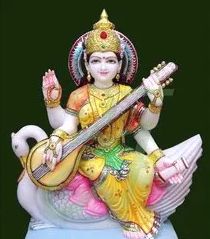
Varada-abhaya-shuka-pustaka-kara-kalitaam kamala-madhyagam kalaye |
kamalam- sasmitavadanam –kanaka-avarana-sthitaam kanchith ||
Mantra Five
चन्द्रां प्रभासां यशसा ज्वलन्तीं श्रियं लोके देवजुष्टामुदाराम् |
तां पद्मिनीमीं शरणमहं प्रपद्येऽलक्ष्मीर्मे नश्यतां त्वां वृणे ||५||
Chandrám prabhásám yaśhasá jvalantím śhriyam lóke deva justám udárám
Tám padminim-ím saranam aham prapadye’ alakshmír me naśyatám tvám vrne| (5)
[The Rishi of the mantra is Ananda; its Chhandas is Trishtubh; and, its Devata is Sarava-aishwarya-prada-lakshmi, the Lakshmi that grants all kinds of riches. Cham is the Bija; Nam is the Shakthi; and, Shrim is the Kilaka. Its viniyoga is nidhi-prapti, shatru-jayam.]
I submit to the mercy of Lakshmi , who is beautiful as the mellow glow of the moon; who is surrounded by lotus flowers; who is generous and kind; who is adored by gods; and whose renown lights up all the worlds. I seek refuge in that resplendent Sri. May she destroy all my misfortunes.
***
12.1. This verse re-calls Sri’s association with the moon, as referred to in the first verse. Sri is of the nature of moon that spreads happiness (aahlada), brightness (prabhasam); of beauty (Chandrah chandate), and of delight that lights up hearts of all (sakala-jana-ahlada–karini).
12.2. The mantra further glorifies Sri as one who sustains and supports all life in the nature (Shriyam loke); fulfils the desire of all; and, is beloved by all beings, including the gods (deva justám). The generous (udárám) Sri is indeed the Mother (taam Padmanemim); and. is the refuge of all the worlds.
12.3. Sri’s association with lotus is again elaborate d in this verse. Lotus (Padma), as said, symbolizes life that is characterized by beauty, purity, grace and abundance. Sri is of the nature of Padma ; and, the whole existence is but the projection of Sri.
13.1. The devotee submits (sharanamaham prapadye) to Sri, praying for release from the blight of A-lakshmi (the opposite of Lakshmi; and, who stands for everything that Lakshmi is not). Though A-lakshmi is personified in the legends as Jyeshta the elder sister of Lakshmi, it essentially signifies the aspects of wretchedness, misery, ugliness and cruelty that disfigure life. Lakshmi, on the other hand, is everything that is auspicious, prosperous, beautiful and virtuous.
13.2. The prayer is to drive away the evil that has taken shelter in the hearts of men/women; and, to invite Lakshmi into the purity of one’s heart-lotus (amala-kamala–hrud-deshe).
14.1. The Dhyana-sloka of the verse is dedicated to Sri Lakshmi who is seated amidst the splendorous solar-orb, holding lotus and gesturing assurance. She is richly decorated with gorgeous dresses, sparkling ornaments and holding the most precious Chintamani jewel. She grants fulfilment of all desires; and destroys misfortunes. I pray to that Supreme Goddess.
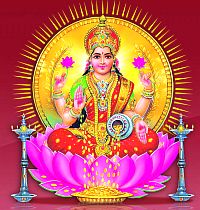
Tejomandala-madyagam dwi-nayanam divya-ambara-alankritaam
devim padma-vara-abhayam kara-talai-chintaamanim bibhratiim |
nana- divya-vibhushanam cha bhajatam daurbhagya-samhaarinim
nana-abhiishta- vara-pradana-niratam vande param devataam ||
Mantra Six
आदित्यवर्णे तपसोऽधिजातो वनस्पतिस्तव वृक्षोऽथ बिल्वः |
तस्य फलानि तपसा नुदन्तु मायान्तरायाश्च बाह्या अलक्ष्मीः ||६||
Ǎditya varne tapasó dhijátó vanaspatis tava vrikshó’ tha bilvah
Tasya phalani tapsá nudantu mayántaráyás cha báhya alakshmíh|| (6)
[The Rishi of the mantra is Ananada; its Chhandas is Trishtubh; and, its Devata is Mahalakshmi. Aaam is the Bija; Shrim is the Shakthi; and, Hrim is the Kilaka. The viniyoga of the mantra is Arogya-aishwarya-abhiruddhi.]
Oh Devi, you are splendorous like the rising sun. By the intense power of your penance (tapas), the wondrous medicinal plant Bilva was brought forth. Let the Bilva-fruits, ripened by the radiance of your austerities; eradicate the ailments caused by the inner and external impurities.
***
15.1. There are some mythological and other references in this verse.

15.2. To start with, Bilva (Aegle marmelos) or Baelis is the Indian wood apple tree. It is referred to in this verse as a Vanaspathi that belongs to Sri (vanaspatis tava vrikshó’ tha bilvah). In the Indian texts, Vanaspathi is described as a class of trees that bear fruit ; but, no blossoming or flowers (a-pushpah, phalavantah). The tree is also described as sada-phala (always bearing fruit), durarudha (difficult to climb) and trishikha or tridala (leaves having three points).
15.3. The Bilva fruit, skin, leaves and roots are said to be lively (sri-yukta), having great medicinal properties. Ayurveda recognizes Bilva fruit as an effective remedy for diarrhoea, dysentery, loss of appetite and abdominal pains. Its roots and leaves help in reducing fever. It is also said to be useful in removing mental imbalance (chitta-dosha-hara) and bodily problems (sarira-dosha-hara). The Bilva is thus a cure for both the internal and external ailments.
15.4. The Bilva tree is regarded sacred, for many other reasons also. It is associated with Shiva as also with Lakshmi. The worship with Bilva–leaves (Bilva-patra) is said to be greatly pleasing to Shiva, as it is very dear to Shiva (mahadevasya cha priyam). And, the Bilva tree is therefore called Shiva-druma, the tree of Shiva; and, its fruits are hailed as jnana-phala, the fruits of knowledge of Shiva.
The Bilvashtakam opens with the verse hailing the virtues and powers of Bilva leaf
Tridalam triguNaakaaram trinetram cha triyaayudham / trijanma paapasamhaaram eka Bilvam shivaarpaNam
I offer the bilva patra to Shiva. This leaf embodies the three qualities of sattva, rajas and tamas. This leaf is like the three eyes, and the sun, moon and fire. It is like three weapons. It is the destroyer of sins committed in three earlier births
There is a faith that offering of a Bilva bestows merit as do ten million yagnas (kotikanyaa mahaadaanam eka bilvam shivaarpaNam ).
The Bilva vriksha is also associated with goddess Sri (Laxmyaa stnam unpanam ). Bilva is the tree of Lakshmi. Tantra regards Bilva vriksha as the form of Lakshmi (Lakshmi swarupa); and, its fruit as Sri-phala, the fruit of Sri. According to a narration in Kalika Purana, Sri performed penance amidst the Bilva trees; and, because of her grace (anugraha) the Bilva fruits acquired unique medicinal properties.
There is the faith that Lakshmi resides in Bilva tree; and, the worship with Bilva-leaves is dearer to her, and hence to Vishnu.The Laksmi Tantra (Pancaratra Agama) mentions that Vishnu temple should preferably be surrounded by Bilva grove.
[Interestingly, during the time of Sri Ramanuja, the practice of worshiping Sri Venkateswara at Tirumala with Bilva leaves came under question. It is said; Sri Ramanuja defended the practice by quoting the sixth verse of Srisukta; and asserted that whatever was dear to Lakshmi was also dear to Vishnu.
Further , even to this day in Bengal , the annual worship of Devi that begins in autumn (sharad-ritu), which marks the coming of the harvest season, is inaugurated by invoking (or awakening) her presence in the branch of the Bilva tree. The faith is that the goddess resides in Bilva .]
16.1. The mantra prays to Sri , radiant like the rising sun (taruna-arunava daruna varne) for cleansing of inner and external impurities (mayántaráyás cha báhya alakshmíh). The term A-lakshmi here, refers to ignorance ; and , to depravity in ones thinking and in ones conduct.
17 .1. The Dhyana-sloka of this verse is dedicated to the Devi, radiant as the rising sun, residing amidst Bilva grove, and rescuing the devotees from ignorance, disease and misfortunes.
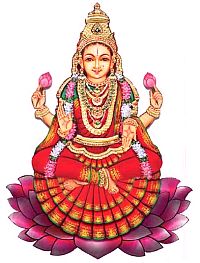
Udyada-aditya-sankaasham bilva-kaanana- madhyagaam |
tanu-madhyam sriyam dhyayed- lakshmi-parihaarinim ||
Mantra Seven
उपैतु मां देवसखः कीर्तिश्च मणिना सह |
प्रादुर्भूतोऽस्मि राष्ट्रेऽस्मिन् कीर्तिमृद्धिं ददातु मे ||७||
Upaitu mám deva-sakah kírtis cha maniná saha
Prádūr bhūtó’ smi rashtre’ smin kírtim riddhim dadátu me| (7)
[The Rishi of the mantra is Kubera; its Chhandas is Anustubh; and, its Devata is Manimalini-Mahalakshmi. Om and Shrim are its Bija; Mam and Blum are its Shakthi; and, Shrim is the Kilaka. Its viniyoga is ratna-siddhi and Bhuta-bhaya-nivarana.]
I am born in this state (Rajya). Let the friend of gods along with the fame, fortune, and precious gems come near to me. Grant me renown (distinction) and prosperity.
***
18.1. The verse prays to Lakshmi for riches, fame and prosperity; as also friendship with the highly affluent.
18.2. The term Deva-sakha meaning the friend of gods is interpreted by scholars as referring to Kubera, the Yaksha regent (Dikpala) of the North; and , the Lord and guardian of all the treasures in the world. That is because; Kubera is often described, in the Puranas, as the friend of Shiva, who conferred on Kubera the privilege to grant riches to his devotees – (devashabdo Mahadeve rudhah kuberah tryambaka sakhah). Lakshmi the goddess of wealth; and, Kubera the custodian of treasures are often worshiped together.
18.3. The term Mani is interpreted in two ways. One; Mani is understood as a jewel used as an amulet to guard against evils of all kinds. It, perhaps, was strung on a sutra, thread (say as in, sutre manigana iva) and worn around the neck.
The Mani is also said to refer to Chintamani, the wish-fulfilling gem , which emerged out of the milky ocean
Its other meaning refers to Manibhadra, a Yaksha; and, a friend of Kubera , guarding his treasures. Since the verse prays for the friend- of -gods (Kubera) along with Kirti and Mani, some scholars are inclined to accept it as a reference to Manibhadra, the friend of Kubera.
18.4. Similarly, Kirti is understood as fame; as also as the name of one of the daughters of Daksha-prajapathi. Kirti is a member of Lakshmi’s entourage (Parivara). It is by her grace that one performs deeds that earn fame and fortune.
[The other divine beings in the entourage of Sri are said to be: Mati (intellect); Dyuti (brightness); Pushti (nourishment, vigor); Samriddhi (prosperity); Tushti (happily satisfied); Aarogya (health); Jaya (victory);and, Shraddhaa (diligence).]
18.5. The mantra, according to some, invites Kubera along with his friend Manibhadra and Kirti , the associate of Lakshmi. (as in illustration provided above)
19.1.The Dhyana-sloka of the mantra prays to Manimalini, who is dear to gods; who is also Rajarajeshwari and Lakshmi; and who grants fame, wealth and other desires. Manimalini is one of the many names of the Devi.
[Please refer to the Varna in Kambhoji raga: Mam pahi Sri Raja Rajeswari Sekari Sivasankari Simmavahini Sevaka janapalini Kapalini Manimalini Varadehini]
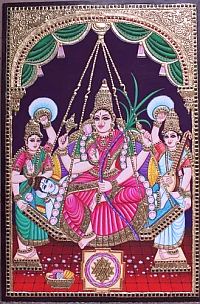
Raajaraajeshwarim- lakshmim varadam manimaaliniim |
devim devapriyam kiirtim vande kamya-artha-siddhaye ||
Continued in Part Three
References and sources
Goddesses in Ancient India by PK Agrawala; Abhinav Publications (1984)
Srisukta (in Kannada) by Prof SK Ramachanra Rao; Published by SAKSI (2209)
I gratefully acknowledge the sublime illustrations of the Sri Sukta which are the creations of the renowned artist of Vedic and traditional themes, Shri GLN Simha of Mysore. These are said to be in the collections of Ramsons Kala Pratishatana, Mysore
http://www.kamakotimandali.com/blog/index.php?p=1140&more=1&c=1&tb=1&pb=
For more about the artist Sri G L N Simha , please click here
https://www.prekshaa.in/Art-Painting-GLN%20Simha-Veda-Scriptures-Tantra-Sukta





















Meenakshi
July 19, 2013 at 2:10 pm
Athi sundar!! Very very well explained. Thank you so much for such a detailed and beautiful explanation!! Only now I understood the exact meaning/interpretation of Sri Suktam!!! I chanced to see this on a Friday and am very thrilled about it.
sreenivasaraos
July 19, 2013 at 2:36 pm
Dear Meenakshi , You are most welcome.
Thanks for the appreciation.
Please do read the other posts as well.
Regards
Mayank Sharma
October 30, 2013 at 4:55 am
Saadhu, Sadhu…..! Great, Sincere and very Coherent Translation and interpretation….! May The Goddess Lakshmi be pleased on you, Your life be full of Ashta-Lakshmi and you in turn become more able to devout for such work, again and again…! Thanks !!
sreenivasaraos
October 30, 2013 at 5:03 am
Dear Mayank, I am glad you read this.
Thank you fr the appreciation; and , for the wishes.
Please do read the other articles too; and, let me know.
Regards
bob
July 28, 2018 at 10:56 am
Hello Mr.Sreenivasa Rao……can you please give exact meaning for “Prádūr bhūtó’ smi” in last verse on this page. Thanks.
sreenivasaraos
July 28, 2018 at 2:47 pm
Dear Bob
Thanks for the visit[ and for the question
The pada-paata, the sequential reading is: Asmin Rastre; pradurbhutah asmi.
I am born in this Kingdom or State. Let the friends of the gods (Deva-sakha) grant me fame, prosperity and fortune.
The term Rastra is, variously, interpreted as Kingdom; State; and fraternity. It is also interpreted as ‘conditioned world’ – the Earth.
And, that again, is stretched to mean Hiranyaloka, said to be the Kingdom of Goddess Sri
I have confined to the commonly interpreted meaning of Rastra.
Regards
K S Narayanan
November 23, 2014 at 6:49 pm
Sriman Sreenivasa Rao Ji
Namaskaram. I am regularly reading your articles posted in your blog; very informative, interesting, useful and enlightening the ignorant. I can imagine how much of voracious reading of many scriptures, recalling those references from memory is required to write even a single page article. There are many hidden secrets in mantra sastra, agama, tantra sastra which can guide us to lead a peaceful, healthy life since human life is the rarest opportunity given to us by the Almighty. Hence I don’t wish to waste even an hour and well read scholars like you only can quench the spiritual thirst.
I humbly request you to to enlighten us / help us to enrich our knowledge, wisdom about SRI ASHTA MUKHA GANDABERUNDA NARASIMHA [SAMGN] by posting your articles on this secretive form of Narasimha, which I believe is hidden in ATHARVA VEDA in mantra saram portion. Please post SAMGN avatara vaibhavam, prabhavam, his mantras, stothras and upasana padhdhati if any.
There is a specific reason for requesting you; four years ago my health was affected due to tongue cancer and I underwent a major surgery for tongue cancer; tongue was removed and reconstruction of tongue was done by plastic surgery. While I was in the hospital, I was directed in my dream by Sri Lakshmi Narasimha to perform upasana on SAMGN and was blessed with regaining speech ability after 3 months, that too on a Swati star and Pradosham combined day.
Now I am daily doing Narasimha Anushtup Mantra Japam. So far 46 Swati Homams were performed. Group of wellwishers joined together are seeking divine grace to establish a temple for SAMGN and we need SAMGN specific mantras, stothras for nithya puja, japam and homam. There is not even single inch of commercial motive but praying for divine guidance for materialisation of this maha bagyam. Hence my humble request to you.
I have been offering KP system of astrology guidance for the past 30 years and vastu guidance for the past 12 years, both as absolutely FREE service. Similar to this by establishing a temple for SAMGN, thousands of people can be blessed with divine grace of SAMGN.
Also I read from few sources that Pratyangira has 6 forms known as Brahmi Pratyangira, Narayani Pratyangira, Roudri Pratyangira, Atharvana Badrakali Pratyangira, Ugra Krtya Pratyangira and Maha Krtya Pratyangira. Is NARAYANI PRATYANGIRA related to worship of NARASIMHA in his female manifestation as NARASIMHI?.
If personal meeting with your goodself is essential, I am very much willing to meet you in person. I am living in T.Nagar, Chennai and request you to email your full address, phone, email contact details so that I will fix up an appointment with you to seek your blessings, guidance and help.
Warm Regards, Dasan
K S Narayanan
sreenivasaraos
March 17, 2015 at 5:05 pm
Thanks for everything you have written. Back after a long time. Want to read the agama series too. Long ago I asked about it. I dont know how much this little mind can understand and retain!
Yes, the new Sulekha is not so user friendly —
Regards and best wishes for 2013.
Padma Raghavan
sreenivasaraos
March 17, 2015 at 5:05 pm
Dear Padma Raghavan, Thank you for digging out a forgotten pebble stuck deep within the Sulekha ‘Rivr’ bed. . Thank you also for your good-wishes. I wish you the same.
As you noticed ; I visit Sulekha rather rarely , these days.
Please read the other two parts of Sri Suktha.
Please also read my posts on Sri Gayatri and the one one on Agama and Tantra.
It is a pleasure to see you after a long time.
Regards
arch
April 27, 2015 at 7:32 am
Hi Sir, Can you please give the details about how many times we need to recite the Sri Suktham. Is it required everyday or only fridays are enough ? And the procedure also to do the pooja..
sreenivasaraos
April 28, 2015 at 2:23 am
Dear Arch,
I have no definite idea about this.
However , please check http://www.kamakotimandali.com/srividya/srisukta.html.
In the concluding part of the article , it is said : ” I was told by my guru to recite the Sukta 108 times and then conclude the Japa by chanting these verses.”
Regards
D
November 5, 2019 at 6:51 pm
Sir, Your blog is amazing for seekers like us. Its an oasis of sublime knowledge in a desert of rampant materialism and ignorance. I commend you highly for having the heart to share what you know. Many folks honestly do not. May God bless you !
Quick question. I understand each of the SriSukta is a mantra and for instance in the first verse ,Srim is the Bija of the mantra; Hrim is its Shakthi; and, Klim is its Kilaka. Should these bija’s be chanted as a Samput before and after the mantra or do we just state these during rishi/ kara and anga nysaa ? . Can you please shed some light ? . Is the below usage correct ?
Srim Hrim Klim
Hiraņya varnám hariņīm suvarna-rajata-srajám
Chandrám hiranmayīm lakshmīm jatavedo ma avaha
Klim Hrim Srim
Also do you have any info on Mantra’s of Lakshmi Nrisimha. If you could can you please share or could you point me in the correct direction ?
Thanks a Million Sir !
sreenivasaraos
November 6, 2019 at 3:15 pm
Dear D
Thank you for the visit and for the appreciation.
As I said in Para 10.1 and Para 11 of Part One :
10.1. Each of these fifteen riks is regarded a mantra in its own right. That is, in the sense, each mantra is associated with a Devata, the deity that resides in the mantra (thus, the mantra is Devata, and the Devata is its mantra); each mantra is ascribed to a Rishi who envisioned it; and, each mantra is composed in a particular Chhandas (metrical form).The fifteen riks together, in their integrated form , are also called Samasti-sukta.
If each stanza of Sri Sukta is recited separately, then its Bija , Rishi have to mentioned before its recital ( just as in the case of Sri Gayatri Mantra)
But , while reciting the Samasti form (all the stanzas together- Samasti-sukta) then its Samasti Bija, Devatha , Rishi are to be recited.
As regards Srisukta (taken as Samasti ) , its opening line ‘Hiranya varnám ‘ is its Bija; the second mantra commencing with ‘Tám ma ávaha játavedo’ is its Shakthi ; and , the phrases occurring towards the later part of the seventh mantra ‘kírtim riddhim dadátu me‘ is its Kilaka. (Śrīm Beejam ; Hrīm Shakthih; Klīm kilakam)
This is recited before commencement of the Sukta
*
As regards the Mantra/Stotra of Sri Lakshmi Narasimha; and the Narasimha Kavacha , kindly check the following links . I trust they would of interest to you:
https://sanskritdocuments.org/doc_vishhnu/lakShmInRisiMhastotram.html?lang=sa
https://sanskritdocuments.org/doc_vishhnu/narasimhakavach.html?lang=sa
*
There are also verses that sing the glory of Shri Suktam
https://sanskritdocuments.org/doc_devii/shrIsUktamahAtmyam.html?lang=sa
*
May the Great Mother Bless us All
Regards
D
November 6, 2019 at 11:22 pm
Thanks so much for clarifying . Recently I stumbled on a old book where sri sukta is chanted with certain bija samputs before and after each verse. It was said to be a tantric way of Sri sukta japa.
Just thought of sharing ….I honestly feel immense peace when chanting this sukta. It really is potent.
Thanks again Sir !
bimal vaishnav
November 18, 2021 at 3:29 pm
SirG,
In the third verse;Is it Prabodhinim OR Pramodinim
sreenivasaraos
November 19, 2021 at 8:21 am
प्रबोधिनीम्
Ananya.T
April 12, 2022 at 5:00 pm
Hello Sir, Can you tell me where to find the individual Dhayana-Shloka you’ve added after each stanza of the Sukta? Thank you.
sreenivasaraos
April 12, 2022 at 6:37 pm
Dear Ananya
The texts of the Dhyana Slokas , relating to each verse of the Sri Sukta ; as also the related Yantras , are adopted from the book Sri Sukta , with commentary by Prof. S K Ramachandra Rao , a renowned scholar of great merit
The copies of the Book can be had from the Publisher at
Prof. S K Ramachandra Rao Memorial Trust;
No.305 , 6th Cross ; Jayanagar , First Block;
Bangalore – 560 011.
Phone # 080 26563957
May the Mother bless us all
Regards